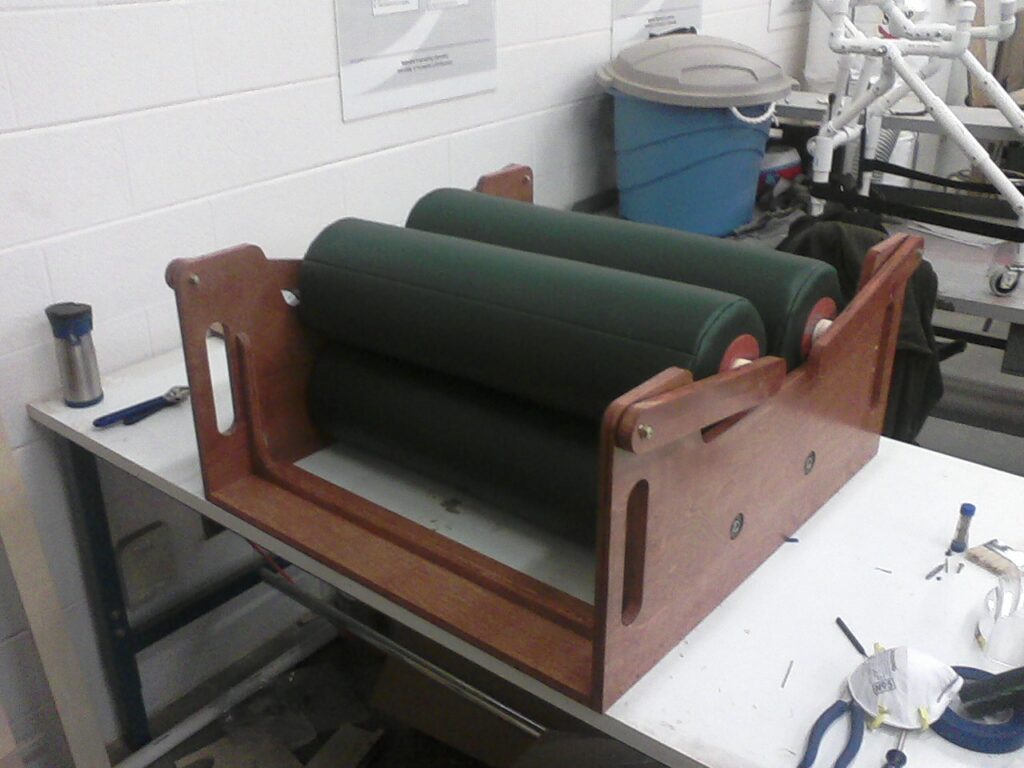Purpose of Therapy Steam Roller and Project Goal
The Comprehensive Development Classroom (CDC) at Waterville Elementary School needs a therapy steam roller. The teacher in the CDC classroom would like a therapy roller to assist children with autism.
The project goal for the therapy roller team is to design and build a therapy steam roller to apply calming pressure to students with sensory issues in the CDC classroom. The students must be able to use the roller independently and be able to exit safely at any time. The roller should be able to apply various levels of pressure. The student needs to be able to easily adjust to the pressure at any time. The therapy roller must be stable in use and withstand abuse.
Background
The therapy steam roller applies deep pressure on the user. Persons with autism deal with sensory issues on a daily basis. For autistic people, sensory stimuli can overwhelm the central nervous system. Sometimes children with autism can suffer from breakdowns due to sensory overload. A soothing pressure can help to reset the nervous system. This can be the difference between a child breaking down and paying attention in class. The therapy roller applies this type of calming pressure.
Although many of the children in the classroom will receive therapeutic assistance from the roller, the main beneficiary is a little boy. He is non-verbal and requires a lot of attention from the teachers. He is more sensitive to sensory overload than many of the other students. The therapy steam roller will be able to assist the teachers in calming him when he experiences sensory overload. Not only will the students benefit from the roller, but the teachers will also be relieved to have a new and improved way to address the sensory issues of students with autism.
Many of the current designs on the market may be suitable to satisfy the needs of the CDC classroom. However, the cost of such devices is too great and does not fit into the budget for the class. The therapy roller team will be able to build a product at a lower cost and donate the roller to the Waterville Elementary CDC classroom.
Design

The therapy steam roller is 33.5″ long, 33″ wide, and 19″ tall. The arms, sides, support slats, and U-braces are all cut from 3/4″ blonde-wood plywood using the CNC router. The wooden parts are stained with a water-based stain and sealed with polyurethane. The bottom rollers are 30″-long standard 1.9″ diameter steel conveyor rollers with 7/16″ hex axles. The top rollers are 30″-long 3/8″ diameter steel conveyor rollers with 1/4″ round axles. Each roller is covered with a 30″-long 8″ diameter super-cushioning polyurethane foam cylinder. The foam is upholstered with dark green vinyl. The hex axles of the bottom rollers sit in stainless steel ball bearings which have been seated in the side panels. The round axles of the top rollers sit in 3/4″ wood cylinders. Rolled steel pins are secured into a drilled hole in the side of the round axle and wood cylinder. The wood cylinder is screwed to the arms of the roller. The arms are secured to the side panels using 1/4″ bolts. Three 1/4″ eye bolts are placed in a line going down the center of the outside of the side panels. A 1/4″ eye bolt is secured to the outside of each arm. 10″ mini-bungees are attached from the eye bolts on the arms to the eye-bolts on the side panels to create tension. A 1/4″ bolt is drilled through rubber stoppers and secured to the side panels under each arm to create a resting point for the top rollers. The support slats are screwed into the side panels on the bottom of each end of the therapy roller. Each slat is 30″ long, 6″ wide, and 3/4″ thick. The two wooden U-braces are placed on the support slats between the side panels and glued and pegged into place to provide additional stability.
Operation
The user enters the therapy steam roller from either side. The user enters with arms first, then with the head. As the user’s body moves through the roller, the top rollers move up and increase the tension in the bungees. The tension in the bungees causes pressure from the top rollers. The weight of the user creates pressure between the user’s body and the bottom rollers. The foam in the rollers helps to evenly distribute the pressure. At this point, the user may either remain in the roller to experience the sustained pressure of the rollers or roll through to exit on the other side.